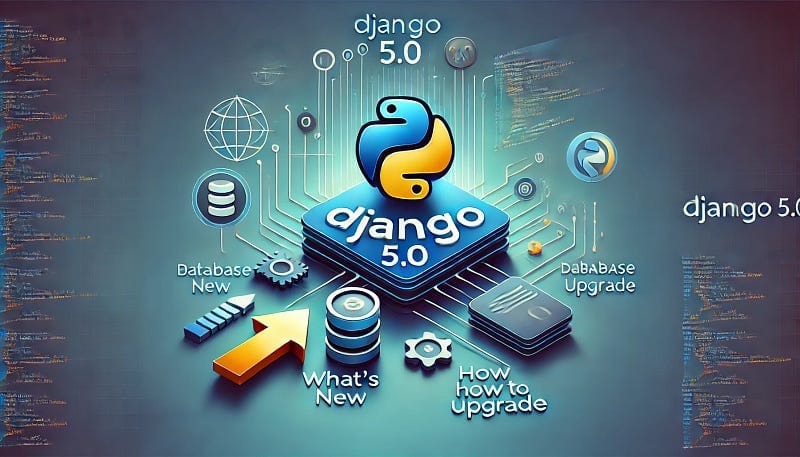Django 5.0: What’s New and How to Upgrade
Django 5.0 is here, bringing a host of improvements, deprecations, and exciting new features. If you’re a Django developer, staying up to…

Django 5.0 is here, bringing a host of improvements, deprecations, and exciting new features. If you’re a Django developer, staying up to date with the latest version is crucial for performance, security, and leveraging new capabilities. In this article, we’ll explore what’s new in Django 5.0, what’s changed, and how you can smoothly upgrade your project.
🚀 Key Features & Improvements in Django 5.0
1. Full Async Support for Class-Based Views
Django has been gradually improving async support, and with version 5.0, class-based views (CBVs) now fully support async execution. This means that views like ListView, DetailView, and FormView can now be written as asynchronous functions, improving performance for high-concurrency applications.
from django.views import View
from django.http import JsonResponse
import asyncio
class AsyncExampleView(View):
async def get(self, request):
await asyncio.sleep(1) # Simulating an async operation
return JsonResponse({"message": "Hello, async Django!"})This enhancement allows Django developers to take full advantage of Python’s async capabilities for handling high-throughput workloads.
2. ModelForm & Form Enhancements
Django 5.0 introduces new features in ModelForm, making form rendering more customizable. Fields now have better default validation and error messages, reducing the need for custom handling.
3. Built-in Support for Storing Passwords in Argon2id
Django now defaults to using Argon2id for password hashing, making authentication more secure. You can enable it in your settings:
# settings.py
PASSWORD_HASHERS = [
'django.contrib.auth.hashers.Argon2PasswordHasher',
'django.contrib.auth.hashers.PBKDF2PasswordHasher',
'django.contrib.auth.hashers.PBKDF2SHA1PasswordHasher',
'django.contrib.auth.hashers.BCryptSHA256PasswordHasher',
]Argon2id is recommended by security experts due to its resistance to brute-force attacks.
4. Enhanced ORM Performance & Query Optimization
Django 5.0 introduces optimizations that improve query performance, especially for complex queries involving joins. The ORM now better utilizes Prefetch and select_related() to minimize redundant queries.
books = Book.objects.prefetch_related('author').all()Optimized queries reduce database load and improve application responsiveness.
5. New Built-in Database Functions
Django 5.0 expands support for window functions and JSON field operations, making it easier to work with modern databases like PostgreSQL and MySQL.
from django.db.models.functions import Rank
from django.db.models import F, Window
queryset = Book.objects.annotate(
rank=Window(expression=Rank(), order_by=F('rating').desc())
)More built-in database functions mean less need for raw SQL queries.
Deprecated Features in Django 5.0
With new features come deprecations. Some of the key removals in Django 5.0 include:
❌ Deprecated urlpatterns as a list – You now must use path() or re_path().
❌ Old Middleware Methods Removed — The older process_request and process_response methods in middleware are fully deprecated.
❌ Python 3.8 Support Dropped — Django 5.0 now requires Python 3.9 or newer.
🔄 How to Upgrade to Django 5.0
Step 1: Check Your Django Version
Before upgrading, confirm which Django version you’re using:
python -m django --versionIf you’re on Django 4.x, you’re ready to upgrade.
Step 2: Update Dependencies
Before upgrading Django, ensure that your dependencies are compatible with Django 5.0. Use pipdeptree to check dependencies:
>> pip install pipdeptree
pipdeptree | grep djangoStep 3: Upgrade Django
Run the following command to install Django 5.0:
pip install --upgrade djangoAlternatively, if you’re using requirements.txt:
pip install -r requirements.txtStep 4: Run Migrations
After upgrading, ensure your database is up to date:
python manage.py migrateStep 5: Test Your Application
Run your test suite to check for compatibility issues:
python manage.py test🚀 Final Thoughts
Django 5.0 is an exciting release that improves performance, security, and developer experience. With full async support, enhanced ORM features, and better security defaults, it’s a great time to upgrade your projects.
Planning to upgrade? Let me know in the comments if you run into any challenges! 🚀💡




